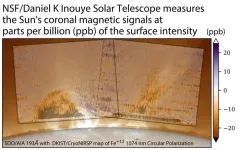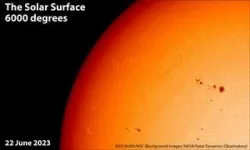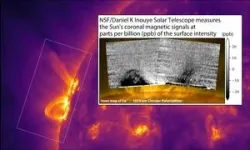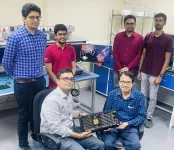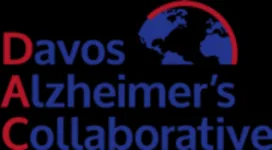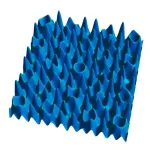(Press-News.org) Summary: The U.S. National Science Foundation (NSF) Daniel K. Inouye Solar Telescope, the world’s most powerful solar telescope, operated by the NSF National Solar Observatory (NSO), achieved a major breakthrough in solar physics by successfully producing its first detailed maps of the Sun’s coronal magnetic fields. This milestone, led by NSO Associate Astronomer Dr. Tom Schad, was recently published in Science Advances, and promises to enhance our understanding of the Sun's atmosphere and how its changing conditions lead to impacts on Earth's technology-dependent society. The corona, or the Sun’s outer atmosphere, greatly influences solar winds and space weather events like solar flares and coronal mass ejections. However, the magnetic forces that drive these events and the corona are challenging to measure.
Embargoed: Not for Release Until 2:00 pm U.S. Eastern Time Wednesday, 11 September 2024.
Maui, Hawaii - The U.S. National Science Foundation (NSF) Daniel K. Inouye Solar Telescope, the world’s most powerful solar telescope, designed, built, and operated by the NSF National Solar Observatory (NSO), achieved a major breakthrough in solar physics by directly mapping the strength of the magnetic field in the solar corona, the outer part of the solar atmosphere that can be seen during a total eclipse. This breakthrough promises to enhance our understanding of space weather and its impact on Earth’s technology-dependent society.
The Corona: The Launch Pad of Space Weather
The Sun's magnetic field generates regions in the Sun's atmosphere, often rooted by sunspots, that store vast amounts of energy that fuel explosive solar storms and drive space weather. The corona, the Sun’s outer atmosphere, is a superheated realm where these magnetic mysteries unfold. Mapping coronal magnetic fields is essential to understanding and predicting space weather - and to protect our technology in Earth and space.
Why It Matters
Earth’s magnetic field shields us from solar winds, protecting our atmosphere, and making life possible. However, the electromagnetic fields and energetic particles from extreme solar eruptions can disrupt satellites, power grids, and other systems we need in our increasingly technological society. Understanding these dynamic interactions, which change on timescales ranging from days to centuries, is crucial for safeguarding our infrastructure and current way of life.
Measuring the corona’s magnetic properties has long challenged astronomers and the limits of technology. Today, the Inouye Solar Telescope is the most advanced facility designed to study the corona, and has made a crucial first step in resolving these mysteries by producing its first coronal magnetic field maps - the most detailed to date.
The Inouye Solar Telescope’s First Maps of the Corona’s Magnetic Field
Since the 1950s, solar physicists have mapped the magnetic fields on the Sun’s surface, providing valuable insights. However, maps of the magnetic field in the zones above the surface, like the corona, have long been sought as it is in these locations that solar storms originate. The Inouye, located near the summit of Maui’s Haleakalā in Hawai'i, now provides the capabilities to meet this critical need.
The Inouye has created its first detailed magnetic field maps of the solar corona using the Zeeman Effect, which measures magnetic properties by observing spectral line splitting. Spectral lines are distinct lines that appear at specific wavelengths in the electromagnetic spectrum, representing the light absorbed or emitted by atoms or molecules. These lines act like “fingerprints,” as they are unique to each atom or molecule, allowing scientists to identify the chemical composition and physical properties of celestial objects by looking at their spectra. When exposed to a magnetic field, like in the Sun, these lines split, which gives us an insight into the object’s magnetic properties. Previous attempts at detecting these signals, last reported two decades ago (Lin et al. 2004), lacked the detail and regularity needed for extensive scientific investigation. Today, the Inouye’s unmatched capabilities allow for detailed, regular studies of these crucial signals.
Technological Marvel
Typically, one can only view the Sun's corona - a region one million times fainter than the solar disk - during a total solar eclipse, when most of the Sun's light is blocked and Earth's sky goes dark. The Inouye, however, uses a technique called coronagraphy to create artificial eclipses, allowing it to detect extremely faint polarized signals - a billion times fainter than the solar disk - highlighting its unparalleled sensitivity and solidifying its status as a unique window to our home star.
The Inouye accomplishes this with its Cryogenic Near-Infrared Spectropolarimeter (Cryo-NIRSP), one of the telescope’s primary instruments used to study the corona and map its magnetic fields. This instrument was designed and built by the University of Hawai‘i Institute for Astronomy.
Dr. Tom Schad’s Research
“The Inouye’s achievement in mapping the Sun’s coronal magnetic fields is a testament to the innovative design and capabilities of this trailblazing unique observatory,” said Tom Schad, scientist at NSO, and first author of the study. “This breakthrough promises to significantly enhance our understanding of the solar atmosphere and its influence on our solar system.”
Future Prospects
This milestone marks the beginning of a new era in solar physics. The Inouye’s success in mapping the Sun’s coronal magnetic fields reaffirms its vision and mission, and opens new frontiers in understanding the Sun’s influence on space weather.
“Just as detailed maps of the Earth's surface and atmosphere have enabled more accurate weather prediction, this thrillingly complete map of the magnetic fields in the sun's corona will help us better predict solar storms and space weather," says Dr. Carrie Black, NSF program director for the NSO. "The invisible yet phenomenally powerful forces captured in this map will propel solar physics through the next century and beyond.”
Christoph Keller, NSO Director, remarks that "Mapping the strength of the magnetic field in the corona is a fundamental scientific breakthrough, not just for solar research, but for astronomy in general.” He anticipates that “This is the beginning of a new era where we will understand how the magnetic fields of stars affect planets, here in our own solar system and in the thousands of exoplanetary systems that we now know about."
Ongoing and future studies will refine diagnostic tools and techniques, leading to deeper insights into the Sun’s magnetic environment and its impact on Earth and our solar system.
More information, including a copy of the paper, can be found online at the Science Advances press package at https://www.eurekalert.org/press/vancepak/ or https://www.science.org/journal/sciadv.
_____
About the U.S. NSF Daniel K. Inouye Solar Telescope
The U.S. National Science Foundation (NSF) Daniel K. Inouye Solar Telescope is operated by the National Solar Observatory (NSO), a federally funded research and development center focused on solar research, under management by the Association of Universities for Research in Astronomy (AURA). The Inouye and NSO are funded by NSF through a cooperative agreement with AURA. The Inouye Solar Telescope is located on land of spiritual and cultural significance to Native Hawaiian people. The use of this important site to further scientific knowledge is done so with appreciation and respect. For more information, visit www.nso.edu.
The Inouye is the largest solar telescope in the world. With a focus on understanding the Sun’s explosive behavior, observations of magnetic fields are at the forefront of this innovative telescope. A combination of an off-axis design, to reduce scattered light, and cutting-edge polarimetery produces the first ongoing measurements of the magnetic fields in the Sun’s corona. The Inouye’s 4-meter mirror provides views of the solar atmosphere like we have never seen before. Focusing on small observing changes, the cutting-edge instrument suite gathers unprecedented images from the Sun’s surface to the lower solar atmosphere. The Inouye Solar Telescope reveals features three times smaller than anything we can see on the Sun today, and does so multiple times a second. Not only do the world-class instruments and optical assembly allow spectacular imagery, but also have incredible spectroscopic capabilities. Observing the specific fingerprints of hundreds of atoms and ions throughout the solar surface and atmosphere will help us explain the dynamic nature of the Sun’s behavior.
About the U.S. NSF National Solar Observatory
The mission of the U.S. National Science Foundation (NSF) National Solar Observatory (NSO) is to advance knowledge of the Sun, both as an astronomical object and as the dominant external influence on Earth, by providing forefront observational opportunities to the research community. The mission includes the operation of cutting edge facilities, the continued development of advanced instrumentation both in-house and through partnerships, conducting solar research, and educational and public outreach.
Contact
For media inquiries, please contact:
Evan Pascual
Communications Specialist
U.S. NSF National Solar Observatory
media@nso.edu
For science inquiries, please contact:
Tom Schad
Associate Astronomer
U.S. NSF National Solar Observatory
tschad@nso.edu
END
Groundbreaking achievement: NSF Daniel K. Inouye solar telescope produces its first magnetic field maps of the sun’s corona
2024-09-11
ELSE PRESS RELEASES FROM THIS DATE:
Landmark study reveals how antibiotics contribute to inflammatory bowel disease risk
2024-09-11
In a landmark study published today in Science Advances, Dr. Shai Bel and his research team at the Azrieli Faculty of Medicine of Bar-Ilan University have uncovered crucial insights into how antibiotic use increases the risk of inflammatory bowel disease (IBD).
The study demonstrates that antibiotics interfere with the protective mucus layer in the intestine, a discovery that could reshape our understanding of antibiotic effects and IBD development.
IBD, which includes Crohn’s disease and ulcerative colitis, affects approximately 1% of the global population. This debilitating condition is ...
Neuromorphic platform presents huge leap forward in computing efficiency
2024-09-11
In a landmark advancement, researchers at the Indian Institute of Science (IISc) have developed a brain-inspired analog computing platform capable of storing and processing data in an astonishing 16,500 conductance states within a molecular film. Published today in the journal Nature, this breakthrough represents a huge step forward over traditional digital computers in which data storage and processing are limited to just two states.
Such a platform could potentially bring complex AI tasks, like training Large Language Models (LLMs), to ...
Genetics of dementia in African and underrepresented populations presented
2024-09-11
Regions of the genome associated with Alzheimer’s disease and dementia in African populations will be presented at the Future of Dementia in Africa conference on September 11-12, 2024. The studies highlight discrepancies compared to Caucasian populations and underscore that a lack of diversity in genomic studies potentially limits the effectiveness of targeted therapies across diverse populations.
The Future of Dementia in Africa conference will take place at the J.W. Marriott Hotel in Nairobi, Kenya. It is a Nature Conference, ...
Turning seawater into fresh water through solar power
2024-09-11
Researchers at the University of Waterloo have designed an energy-efficient device that produces drinking water from seawater using an evaporation process driven largely by the sun.
Desalination is critical for many coastal and island nations to provide access to fresh water, given water scarcity concerns due to rapid population growth and increasing global water consumption. Roughly 2.2 billion people worldwide have no access to clean water, emphasizing the urgent need for new technologies to generate fresh water, according to the UN World Water Development Report 2024.
Current desalination systems pump seawater through membranes to ...
How the oceans’ most abundant bacteria impact global nutrient flows
2024-09-11
If you were to collect all the organisms from the ocean surface down to 200 meters, you’d find that SAR11 bacteria, though invisible to the naked eye, would make up a fifth of the total biomass. These bacteria, also known as Pelagibacterales, have evolved to thrive in nutrient-poor marine environments and play a significant role in global nutrient cycles. Despite their importance, the mechanisms behind their impact on the planetary ecosystem have remained unclear.
But now, a recent Nature paper by researchers from the Okinawa ...
Discovery of a new phase of matter in 2D which defies normal statistical mechanics
2024-09-11
Physicists from the Cavendish Laboratory in Cambridge have created the first two-dimensional version of the Bose glass, a novel phase of matter that challenges statistical mechanics. The details of the study have been published in Nature.
As the name suggests, the Bose glass has some glassy properties and within it all particles are localised. This means that each particle in the system sticks to itself, not mixing with its neighbours. If coffee was localised, then when stirring milk into the coffee, the intricate pattern of black and white stripes would remain forever, instead of washing out to an average.
To create this new phase of matter, the group overlapped several laser ...
Genes with strong impact on menopause timing also link to cancer risk
2024-09-11
New research has found four genes with some of the largest known effects on the timing of menopause discovered to date, providing new insight into links between menopause timing and cancer risk.
Genes come in pairs, and when women only have one working copy of the four new genes identified (ETAA1, ZNF518A, PNPLA8, PALB2), they have menopause between two and five-and-a-half years earlier than average.
Published in Nature, the large-scale analysis was funded by the Medical Research Council and Wellcome. The team first looked at variation in data from genetic sequencing of 106,973 post-menopausal ...
Ancient DNA from Rapa Nui (Easter Island) refutes best-selling population collapse theory
2024-09-11
Rapa Nui or Te Pito o Te Henua (the navel of the world), also known as Easter Island, is one of the most isolated inhabited places in the world. Located in the Pacific, it lies over 1,900 km east of the closest inhabited Polynesian island and 3,700 km west of South America. Although the island, its inhabitants and their rich culture have been extensively studied by archaeologists, anthropologists and geneticists, two key elements of Rapanui history remain very controversial to this day. One of these is the theory of population collapse through "ecocide" or "ecological ...
Researchers combine the power of AI and the connectome to predict brain cell activity
2024-09-11
With maps of the connections between neurons and artificial intelligence methods, researchers can now do what they never thought possible: predict the activity of individual neurons without making a single measurement in a living brain.
For decades, neuroscientists have spent countless hours in the lab painstakingly measuring the activity of neurons in living animals to tease out how the brain enables behavior. These experiments have yielded groundbreaking insights into how the brain works, but they have only scratched the surface, leaving much of the brain unexplored.
Now, researchers are using artificial intelligence and the connectome – a ...
New research shows clinical trials inappropriately excluding people of African/Middle Eastern descent
2024-09-11
BOSTON – Many clinical trials of new cancer drugs may be inappropriately excluding some people with "Duffy-null phenotype," a trait found predominantly in people of African or Middle Eastern descent, researchers at Dana-Farber Cancer Institute and Queen Mary University of London report in a new study.
The Duffy-null phenotype results in relatively lower levels of white blood cells called neutrophils when measured in the blood. This is not because they have less neutrophils overall, but because they are more frequently located in other body tissues. Tests that restrict clinical trial eligibility to patients with certain blood levels of neutrophils may therefore ...
